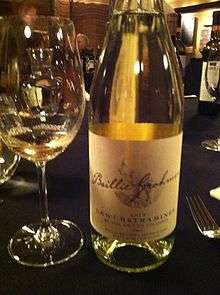British Columbia wine
 |
| Part of a series on |
| Canadian cuisine |
|---|
|
Regional cuisines |
|
Religious & ethnic |
|
British Columbia wine is Canadian wine produced in the province of British Columbia. Wines made from 100 percent British Columbia grapes can qualify for classification under one of British Columbia's two classification systems, depending on the varietal, the wine-making techniques employed, and various other restrictions.
Originally, the British Columbia Wine Institute handled regulation and marketing of the Vintners Quality Alliance (VQA), which is also an appellation system. More recently, the British Columbia Wine Authority was formed by the provincial government to regulate part of the industry. It created a second classification, "Wines of Distinction", to be also from 100 percent British Columbia grapes, but with less stringent quality control. In practice, it has strengthened the VQA classification.
British Columbia is gaining recognition for its world-class premium VQA wines. Wines which are neither labelled VQA or Wine of Distinction, and from certain producers (given special rights under the 1988 Canada-United States Free Trade Agreement), can use foreign bulk wine to produce a third category of wine which is labelled as Cellared in Canada. Significant parts of the wine industry, and respected wine writers in Canada and abroad, are quite concerned about this practice.
There are several classifications of winery, represented by numerous organizations. The smallest are known as "farmgate" wineries. "Land" wineries are mid-sized operations.
Climate
Although Canada has a reputation for having a cold climate, much of the British Columbia Interior has a mild or dry climate which is ideal for growing grapes. Within the Interior, the Okanagan Valley in particular is known for both the high quality of its wines, and for its increasing number of respected wineries, smaller pockets such as the Creston Valley have been emerging of late, with very high quality first epoch Vinifera varietals . On the Coast, the Cowichan Valley on Vancouver Island and the Fraser Valley in the Lower Mainland are also wine-growing regions, though experimentation with vines has happened in various southerly areas of the province.
Varieties

The most prominent varieties of grapes grown in British Columbia are:
For red wine and rose production:
- Merlot
- Pinot noir
- Cabernet Sauvignon
- Syrah (Shiraz)
- Cabernet Franc
- Gamay
- Marechal Foch
- Malbec
- Petit Verdot
- Zweigelt
For white wines:
- Pinot gris
- Chardonnay
- Gewürztraminer
- Sauvignon blanc
- Pinot blanc
- Riesling
- Viognier
- Ehrenfelser
- Semillon
- Bacchus
Growing regions
Based on their unique terroir, there are five official viticultural areas in the province which are recognized by the VQA. Wines bearing the name of a viticultural area are produced from a minimum of 95 percent of the grapes grown in the designated area.[1]
- Okanagan Valley
- Similkameen Valley
- Fraser Valley
- Vancouver Island (includes Cowichan Valley)
- Gulf Islands
- Emerging regions:
- The Kootenay
- Thompson/Shuswap
- Lillooet

Association of BC Winegrowers
The Association of British Columbia Winegrowers (ABCW) is an association of winemakers located in British Columbia. Most of the member wineries are small lot producers (less than 5,000 cases produced each year), family-owned and -operated. Their wines are all made from 100% BC-grown fruit. The ABCW's 57 members account for over 70% of the province's wineries.[2]
In 2007, the ABCW created BC WineCast, an audio podcast exploring hidden wineries of British Columbia.[3]
See also
- Wines of British Columbia
- Cool Climate Oenology and Viticulture Institute
- Ice wine
- Blasted Church Vineyards
- Blue Mountain Vineyard
- Jackson-Triggs
- Quails' Gate Winery
References
External links
- Wines of British Columbia
- Association of B.C. Winegrowers
- British Columbia Estate Winery Association
- Map of British Columbia Wineries